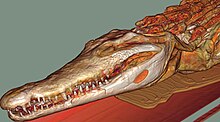West African crocodile
| West African crocodile | |
|---|---|

| |
| Specimen in Bazoulé, Burkina Faso | |
| Scientific classification | |
| Domain: | Eukaryota |
| Kingdom: | Animalia |
| Phylum: | Chordata |
| Class: | Reptilia |
| Clade: | Archosauromorpha |
| Clade: | Archosauriformes |
| Order: | Crocodilia |
| Family: | Crocodylidae |
| Genus: | Crocodylus |
| Species: | C. suchus
|
| Binomial name | |
| Crocodylus suchus Geoffroy, 1807
| |
| Synonyms | |
| |
The West African crocodile, desert crocodile, or sacred crocodile (Crocodylus suchus)[2] is a species of crocodile related to — and often confused with — the larger and more aggressive Nile crocodile (C. niloticus).[3][4]
Taxonomy

The species was named by Étienne Geoffroy Saint-Hilaire in 1807, who discovered differences between the skulls of a mummified crocodile and those of Nile crocodile (C. niloticus). This new species was, however, long afterwards regarded as a synonym of the Nile crocodile. In 2003, a study resurrected C. suchus as a valid species,[3] and this was confirmed by several other studies in 2011–2015.[5][6][7]
Despite the long history of confusion, genetic testing has revealed that the two are not particularly close. The closest relatives of the Nile crocodile are the Crocodylus species from the Americas, while the West African crocodile is basal to the clade of Nile and American crocodiles.[8][9][10]
Below is a
| Crocodylinae |
| ||||||||||||||||||||||||||||||||||||||||||||||||||||||||||||||||||||||||||||||||||||||||||||||||
Characteristics

The muzzle is short and thick. The distance between the eyes and the tip of the muzzle is 1.5 to 2 times longer than the width of the muzzle at the level of the front edge of the eyes (1.2 to 1.5 times in case of juveniles). The coloration is generally brown to olive. Juveniles are paler, with black bandings, especially on the tail. Like all other species of crocodiles, the West African crocodile's eyes reflect light at night allowing it to be spotted easily through a flashlight. It is found to be active day and night. It can stay submerged underwater for more than 30 minutes, and can reach speeds of up to 30 km/h (19 mph) in short bursts. On land, it is often observed basking motionless in the sun, often with its mouth agape.[11]
Compared to the Nile crocodile, which can grow over 5 m (16 ft 5 in) in length, the West African crocodile is smaller. It typically grows between 2 and 3 m (6 ft 7 in and 9 ft 10 in) in length, with an occasional male growing over 4 m (13 ft 1 in) in rare cases.[12] Adults weigh between 90 and 250 kg (200 and 550 lb), with particularly large male specimens exceeding 300 kg (660 lb) in weight.[13][14]
Distribution and habitat
The West African crocodile inhabits much of
In Mauritania the species has adapted to the arid desert environment of the
Relationship with humans
The West African crocodile is less aggressive than the Nile crocodile,[4] but several attacks on humans have been recorded, including fatal ones.[19] Mauritanian traditional peoples who live in close proximity to West African crocodiles revere them and protect them from harm. This is due to their belief that, just as water is essential to crocodiles, so crocodiles are essential to the water, which would permanently disappear if they were not there to inhabit it. Here the crocodiles live in apparent peace with the humans, and are not known to attack swimmers.[16]
In ancient Egypt

The people of
Sobek was depicted as a crocodile, as a
; other temples were scattered across the country.Historically, C. suchus inhabited the Nile in
In captivity

The West African crocodile only received wider recognition as a valid species in 2011. Consequently, captives have typically been confused with other species, especially the Nile crocodile.
References
- ^ "Appendices | CITES". cites.org. Retrieved 14 January 2022.
- ^ Crocodylus suchus, The Reptile Database
- ^ .
- ^ .
- ^ Nile crocodile is two species, Nature.com
- ^ PMID 21906195.
- ^ a b Cunningham, S.W. (2015), Spatial and genetic analyses of Africa's sacred crocodile: Crocodylus suchus, ETD Collection for Fordham University
- PMID 21459152.
- ^ PMID 30051855.
- ^ PMID 33907305.
- ISBN 978-2-7099-1726-1.
- ISBN 978-2-7099-1726-1.
- PMID 35158720.
- S2CID 247728849.
- ^ S2CID 82155811.
- ^ a b Mayell, H. (18 June 2002). "Desert-Adapted Crocs Found in Africa". National Geographic.com. Archived from the original on 22 July 2018. Retrieved 24 December 2013.
- .
- S2CID 85775155.
- ^ Sideleau, B.; Shirley, M. "West African crocodile". CrocBITE, Worldwide Crocodilian Attack Database. Charles Darwin University, Northern Territory, Australia. Retrieved 17 December 2018.
- ^ "Sobek, God of Crocodiles, Power, Protection and Fertility..." Archived from the original on 25 July 2017. Retrieved 17 March 2007.
- ISSN 0362-4331. Retrieved 19 January 2023.
- ^ Larsen, H. (5 January 2014), Københavnerkrokodiller har skiftet art, Politiken
- ^ Ziegler, T.; S. Hauswaldt & M. Vences (2015). "The necessity of genetic screening for proper management of captive crocodile populations based on the examples of Crocodylus suchus and C. mindorensis". Journal of Zoo and Aquarium Research. 3 (4): 123–127.
